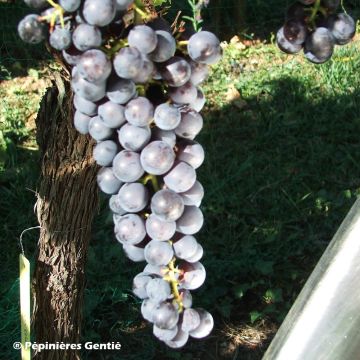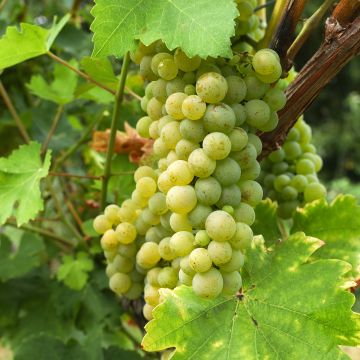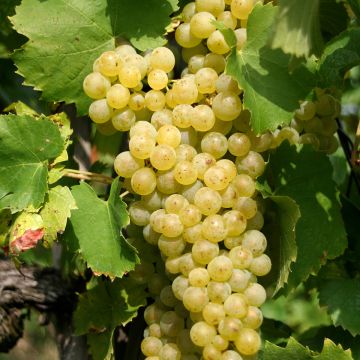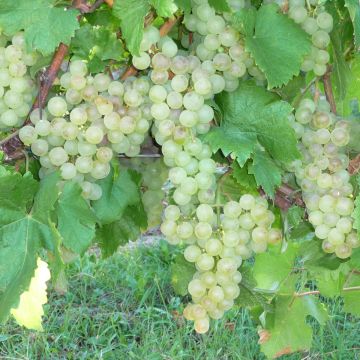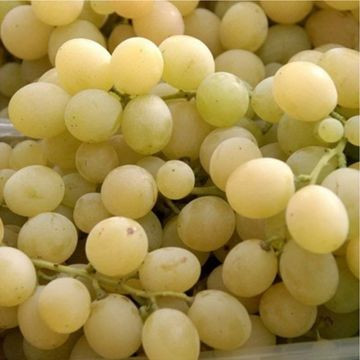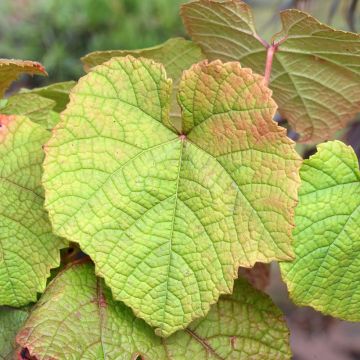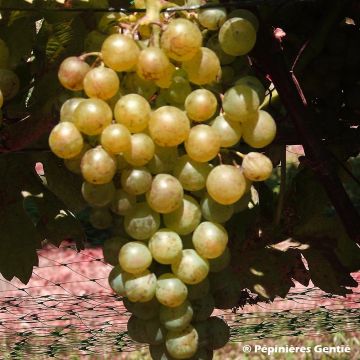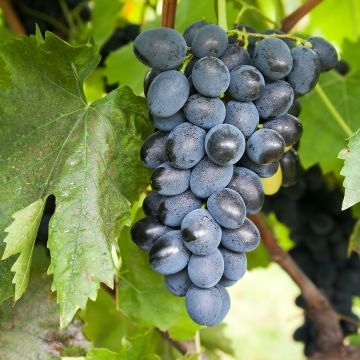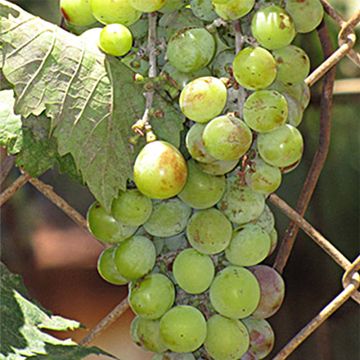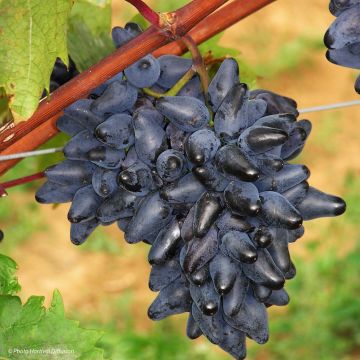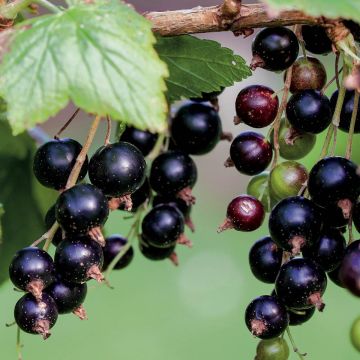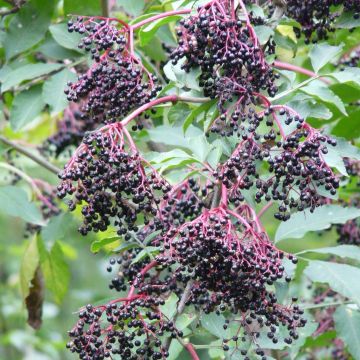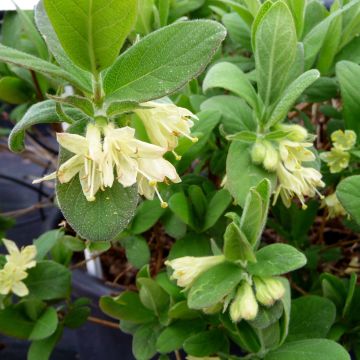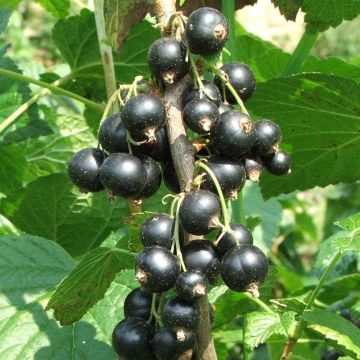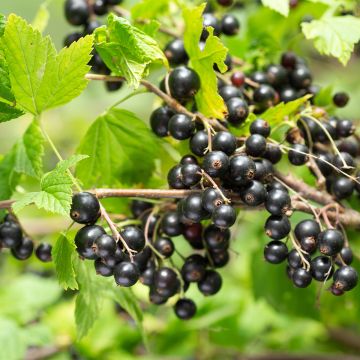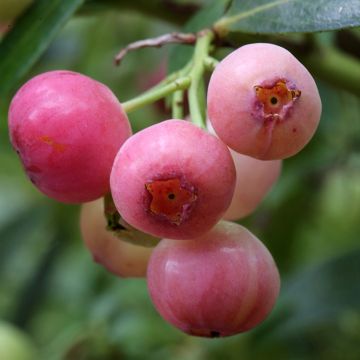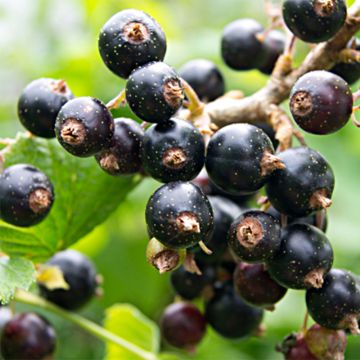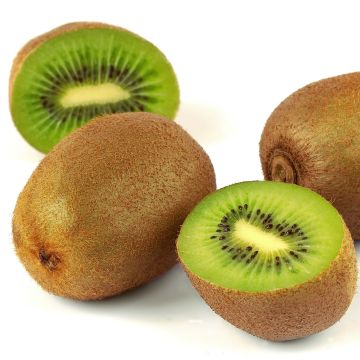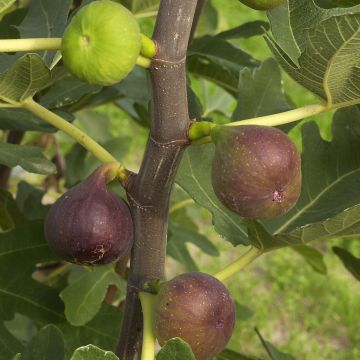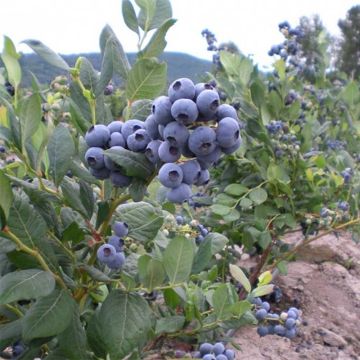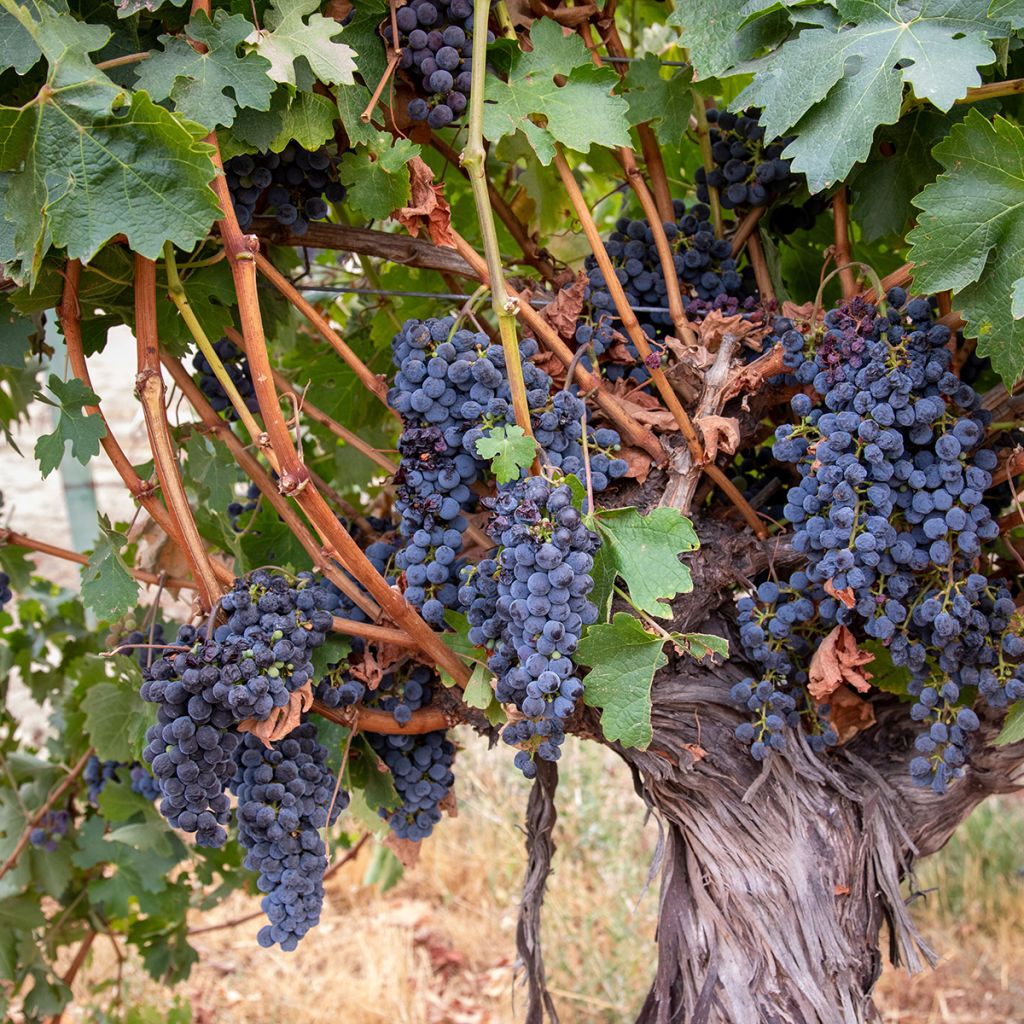

Vitis vinifera Barbera - Grapevine
Vitis vinifera Barbera - Grapevine
Vitis vinifera Barbera
Common Grapevine, European Grape
This item cannot be shipped to the selected country
Delivery charge from €5.90
More information
Schedule delivery date,
and select date in basket
This plant carries a 6 months recovery warranty
More information
We guarantee the quality of our plants for a full growing cycle, and will replace at our expense any plant that fails to recover under normal climatic and planting conditions.
From €5.90 for pickup delivery and €6.90 for home delivery
Express home delivery from €8.90.
Description
The 'Barbera' Vine is a native grape variety from the Piedmont region in Italy. It is black and quite acidic when young, with fine tannins, and as it ages, it becomes dense with a taste of sour cherries. The colour of the wine is intense, with a fruity flavour and a noticeable acidity that gives it freshness and liveliness. This grape, used for wine production, is bluish-black, with thick and powdery skin, and the clusters are large, elongated, and moderately compact. The plant has good resistance to diseases. The Barbera grapes are usually harvested in late September to early October. It is considered ideal for planting in limestone and clay soils, which are not very fertile.
The wine grape vine (Vitis vinifera) grew wild over 5000 years ago. Many hybrids were created to vary colours, flavours, and uses. Barbera is an ancient variety of Italian origin, from the Piedmont region. More specifically, its origins are in the Monferrato area, which borders the regions of Asti and Alba in the southeast of Piedmont. It was first mentioned in the 6th century. Recent DNA data suggests that Barbera could be related to the Franco-Spanish grape variety Mourvedre. Considered for a long time as a grape of average quality, serious winemakers in Piedmont have demonstrated the qualities of Barbera and proved that it can compete with "great wines". Barbera wines are now recognised worldwide. This grape can be used as a single variety or in blends. When young, it offers a very intense aroma of fresh red cherries and blackberries. In lighter versions, there are notes of cherries, raspberries, and blueberries, and in wines made from riper grapes, there are notes of blackberries and black cherries. In Piedmont, this grape is appreciated for its yields and its ability to ripen two weeks earlier than Nebbiolo, even in vineyards with less-than-ideal exposure.
The 'Barbera' Vine is a vigorous climbing vine that can reach up to 5m. Its final shape will depend on the pruning. The vine attaches itself to its support (trellis, espalier...) thanks to its tendrils and prefers sunny situations. It has a semi-erect to horizontal habit. It is advisable to train it on wire and trellis it well. It is indifferent to soil types and udemanding, but it still prefers clay-limestone soils. It will require careful pruning. Its cut leaves are deep green in summer, and the edges of its leaves turn red in autumn. Its flowering in clusters occurs in May, with very small greenish flowers. The 'Barbera' produces quite dark wines, with medium to high acidity, soft tannins, and a light body, often compared to Merlot. It is vigorous and thrives on sandy and clayey soils, however, many producers believe that it could produce very elegant results on limestone-rich soils located in temperate latitudes.
The 'Barbera' grape is consumed as wine after vinification.
Report an error about the product description
Plant habit
Fruit
Flowering
Foliage
Botanical data
Vitis
vinifera
Barbera
Vitaceae
Common Grapevine, European Grape
Western Europe
Other Grapevines
Planting and care
Since the ravages of phylloxera at the end of the 19th century, the vine is grafted onto different rootstocks resistant to this disease and adapted to different types of soil. These rootstocks come from American varieties. Plant the Barbera vine in autumn, in a deep, well-drained, even stony, arid, poor and chalky soil, in a sunny exposure, sheltered from strong winds. Incorporate 3 or 4 handfuls of fertiliser for fruit trees and 2 kg of composted manure into the planting soil for each vine-plant. The roots must not be in contact with the manure. After planting, prune above 2 large buds (buds) to obtain two branches. Keep the most vigorous one, and tie it to a stake. The pruning instructions will follow.
The vine does not require regular fertiliser application, for a good yield, on the contrary. Enrich the soil with potash, crushed horn or iron chelate, only every 2-3 years.
Planting period
Intended location
Care
This item has not been reviewed yet - be the first to leave a review about it.
Berries
Haven't found what you were looking for?
Hardiness is the lowest winter temperature a plant can endure without suffering serious damage or even dying. However, hardiness is affected by location (a sheltered area, such as a patio), protection (winter cover) and soil type (hardiness is improved by well-drained soil).

Photo Sharing Terms & Conditions
In order to encourage gardeners to interact and share their experiences, Promesse de fleurs offers various media enabling content to be uploaded onto its Site - in particular via the ‘Photo sharing’ module.
The User agrees to refrain from:
- Posting any content that is illegal, prejudicial, insulting, racist, inciteful to hatred, revisionist, contrary to public decency, that infringes on privacy or on the privacy rights of third parties, in particular the publicity rights of persons and goods, intellectual property rights, or the right to privacy.
- Submitting content on behalf of a third party;
- Impersonate the identity of a third party and/or publish any personal information about a third party;
In general, the User undertakes to refrain from any unethical behaviour.
All Content (in particular text, comments, files, images, photos, videos, creative works, etc.), which may be subject to property or intellectual property rights, image or other private rights, shall remain the property of the User, subject to the limited rights granted by the terms of the licence granted by Promesse de fleurs as stated below. Users are at liberty to publish or not to publish such Content on the Site, notably via the ‘Photo Sharing’ facility, and accept that this Content shall be made public and freely accessible, notably on the Internet.
Users further acknowledge, undertake to have ,and guarantee that they hold all necessary rights and permissions to publish such material on the Site, in particular with regard to the legislation in force pertaining to any privacy, property, intellectual property, image, or contractual rights, or rights of any other nature. By publishing such Content on the Site, Users acknowledge accepting full liability as publishers of the Content within the meaning of the law, and grant Promesse de fleurs, free of charge, an inclusive, worldwide licence for the said Content for the entire duration of its publication, including all reproduction, representation, up/downloading, displaying, performing, transmission, and storage rights.
Users also grant permission for their name to be linked to the Content and accept that this link may not always be made available.
By engaging in posting material, Users consent to their Content becoming automatically accessible on the Internet, in particular on other sites and/or blogs and/or web pages of the Promesse de fleurs site, including in particular social pages and the Promesse de fleurs catalogue.
Users may secure the removal of entrusted content free of charge by issuing a simple request via our contact form.
The flowering period indicated on our website applies to countries and regions located in USDA zone 8 (France, the United Kingdom, Ireland, the Netherlands, etc.)
It will vary according to where you live:
- In zones 9 to 10 (Italy, Spain, Greece, etc.), flowering will occur about 2 to 4 weeks earlier.
- In zones 6 to 7 (Germany, Poland, Slovenia, and lower mountainous regions), flowering will be delayed by 2 to 3 weeks.
- In zone 5 (Central Europe, Scandinavia), blooming will be delayed by 3 to 5 weeks.
In temperate climates, pruning of spring-flowering shrubs (forsythia, spireas, etc.) should be done just after flowering.
Pruning of summer-flowering shrubs (Indian Lilac, Perovskia, etc.) can be done in winter or spring.
In cold regions as well as with frost-sensitive plants, avoid pruning too early when severe frosts may still occur.
The planting period indicated on our website applies to countries and regions located in USDA zone 8 (France, United Kingdom, Ireland, Netherlands).
It will vary according to where you live:
- In Mediterranean zones (Marseille, Madrid, Milan, etc.), autumn and winter are the best planting periods.
- In continental zones (Strasbourg, Munich, Vienna, etc.), delay planting by 2 to 3 weeks in spring and bring it forward by 2 to 4 weeks in autumn.
- In mountainous regions (the Alps, Pyrenees, Carpathians, etc.), it is best to plant in late spring (May-June) or late summer (August-September).
The harvesting period indicated on our website applies to countries and regions in USDA zone 8 (France, England, Ireland, the Netherlands).
In colder areas (Scandinavia, Poland, Austria...) fruit and vegetable harvests are likely to be delayed by 3-4 weeks.
In warmer areas (Italy, Spain, Greece, etc.), harvesting will probably take place earlier, depending on weather conditions.
The sowing periods indicated on our website apply to countries and regions within USDA Zone 8 (France, UK, Ireland, Netherlands).
In colder areas (Scandinavia, Poland, Austria...), delay any outdoor sowing by 3-4 weeks, or sow under glass.
In warmer climes (Italy, Spain, Greece, etc.), bring outdoor sowing forward by a few weeks.

































